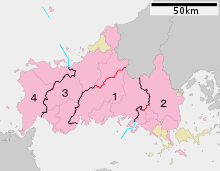Yamaguchi 1st district
Yamaguchi 1st district (山口[県第]1区, Yamaguchi[-ken dai-]ikku) is a single-member electoral district for the House of Representatives, the lower house of the National Diet of Japan. It is located in Yamaguchi and covers the prefectural capital Yamaguchi (without the former town of Atō), parts of the city of Shūnan (the area of former municipalities Tokuyama city, Shinnan'yō city, Kano town) and the city of Hōfu. As of September 2012, 359,151 eligible voters were resident in the district.[2]
| Yamaguchi 1st District | |
|---|---|
| Parliamentary constituency for the Japanese House of Representatives | |
 Numbered map of Yamaguchi Prefecture single-member districts | |
| Prefecture | Yamaguchi |
| Proportional District | Chūgoku |
| Electorate | 362,270 (2017)[1] |
| Major settlements | Yamaguchi, Shūnan, and Hōfu |
| Current constituency | |
| Party | LDP |
| Representative | Masahiko Kōmura |
Before the electoral reform of the 1990s, the area had been part of the five-member Yamaguchi 2nd district which covered roughly the Eastern half of the prefecture and had been the former district of LDP presidents Nobusuke Kishi and Eisaku Satō. Another representative from the pre-reform 2nd district for the LDP was former four-term Tokuyama city mayor Sakahiko Kōmura. When Kōmura retired, his fourth son Masahiko won a seat in the district in 1980 and defended it in all pre-reform elections. After the electoral reform, Masahiko Kōmura took over the new single-member 1st district for the LDP. The main opposition NFP and the newly founded DPJ did not even nominate candidates in the first post-reform election of 1996, his only challengers were a Communist and an unaffiliated independent. In subsequent elections, the enlarged/"New" DPJ did nominate candidates; but Kōmura held onto the seat by large margins, even in the countrywide DPJ victory of 2009. The district remains – like two other of Yamaguchi's districts – an unbroken "conservative kingdom" (hoshu ōkoku).
Kōmura was a minister in several cabinets in the 1990s and 2000s (Murayama, Obuchi, Mori II, Fukuda, Abe I). From 2000 to 2012, Kōmura led the Banchō Seisaku Kenkyūjo (previously Kōmoto faction, now Ōshima faction), one of the smaller, but well-established factions of the LDP that traces its roots to the centrist Reform Party and the pre-war Constitutional Democratic Party. In 2012, LDP president Shinzō Abe (Machimura faction, also from Yamaguchi) nominated him to succeed fellow faction member Tadamori Ōshima as vice president of the party.
List of representatives
| Representative | Election | Party | Term | Notes | |
|---|---|---|---|---|---|
| Shinzo Abe | 1993 | Liberal Democratic Party | 1993-1996 | ||
| Masahiko Kōmura | 1996 | 1996– | Incumbent | ||
| 2000 | |||||
| 2003 | |||||
| 2005 | |||||
| 2009 | |||||
| 2012 | |||||
| 2014 | |||||
| 2017 | |||||
Recent results
| Party | Candidate | Votes | % | ± | |
|---|---|---|---|---|---|
| LDP - Kōmeitō | Masahiro Kōmura | 133,221 | 69.1 | ||
| Kibo | Kazuya Ouchi | 36,582 | 19.0 | ||
| JCP | Hiroshi Goto | 17,924 | 9.3 | ||
| HRP | Miwako Kawai | 5,070 | 2.6 | ||
| Turnout | 197,192 | 54.43 | |||
| Party | Candidate | Votes | % | ± | |
|---|---|---|---|---|---|
| LDP - Kōmeitō | Shinzō Abe | 100,829 | 76.3 | ||
| JCP | Sadayoshi Yoshida | 17,358 | 13.1 | ||
| Independent - PLP | Toshie Watanabe | 14,018 | 10.6 | ||
| Turnout | 132,205 | 52.56 | |||
| Party | Candidate | Votes | % | ± | |
|---|---|---|---|---|---|
| LDP (NK) | Masahiko Kōmura | 133,776 | 65.9 | +8.9 | |
| TPJ (NPD) | Tetsunari Iida | 35,622 | 17.6 | new | |
| DPJ | Satoshi Tomimura | 23,813 | 11.7 | new | |
| JCP | Tomiyuki Uonaga | 9,753 | 4.8 | new | |
| Party | Candidate | Votes | % | ± | |
|---|---|---|---|---|---|
| LDP | Masahiko Kōmura | 142,103[nb 1] | 57.0 | -6.8 | |
| DPJ | Tsutomu Takamura | 94,253[nb 1] | 37.8 | new | |
| JCP | Sadayoshi Yoshida | 10,114 | 4.1 | new | |
| HRP | Jun'ichi Murata | 2,889 | 1.2 | new | |
Note:
- Decimals from anbunhyō omitted
References
- "衆議院小選挙区 - 確定投票状況" [House of Representatives election district - Fixed Vote Status]. Yamaguchi Prefecture Election Commission (in Japanese). 2017.
- MIC: 平成24年9月2日現在選挙人名簿及び在外選挙人名簿登録者数>選挙区ごとの選挙人名簿及び在外選挙人名簿登録者数等 (in Japanese)
- Asahai Shimbun: election results in Yamaguchi's single-member districts
- Asahai Shimbun: election results in Yamaguchi's single-member districts
- 総選挙2012>開票結果 小選挙区 山口. Yomiuri Shimbun (in Japanese). Retrieved 2013-10-09.
- 2009総選挙 開票結果 小選挙区・山口1区. Asahi Shimbun (in Japanese). Retrieved 2013-10-09.